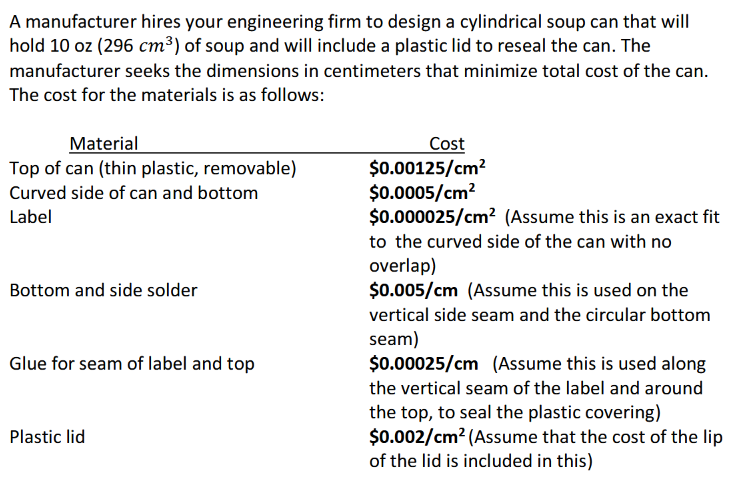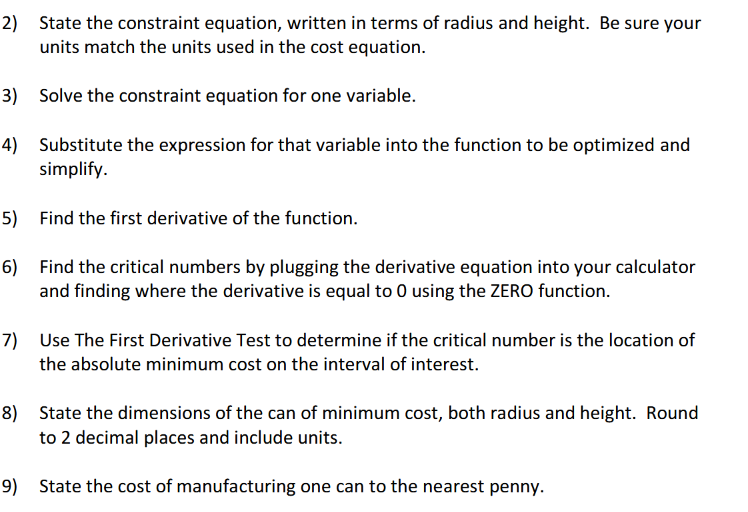

A manufacturer hires your engineering firm to design a cylindrical soup can that will hold 10 oz (296 cm3) of soup and will include a plastic lid to reseal the can. The manufacturer seeks the dimensions in centimeters that minimize total cost of the can. The cost for the materials is as follows: Material Top of can (thin plastic, removable) Curved side of can and bottom Label Bottom and side solder Cost $0.00125/cm2 $0.0005/cm $0.000025/cm (Assume this is an exact fit to the curved side of the can with no overlap) $0.005/cm (Assume this is used on the vertical side seam and the circular bottom seam) $0.00025/cm (Assume this is used along the vertical seam of the label and around the top, to seal the plastic covering) $0.002/cm2 (Assume that the cost of the lip of the lid is included in this) Glue for seam of label and top Plastic lid 2) State the constraint equation, written in terms of radius and height. Be sure your units match the units used in the cost equation. 3) Solve the constraint equation for one variable. 4) Substitute the expression for that variable into the function to be optimized and simplify. 5) Find the first derivative of the function. 6) Find the critical numbers by plugging the derivative equation into your calculator and finding where the derivative is equal to 0 using the ZERO function. 7) Use The First Derivative Test to determine if the critical number is the location of the absolute minimum cost on the interval of interest. 8) State the dimensions of the can of minimum cost, both radius and height. Round to 2 decimal places and include units. 9) State the cost of manufacturing one can to the nearest penny. A manufacturer hires your engineering firm to design a cylindrical soup can that will hold 10 oz (296 cm3) of soup and will include a plastic lid to reseal the can. The manufacturer seeks the dimensions in centimeters that minimize total cost of the can. The cost for the materials is as follows: Material Top of can (thin plastic, removable) Curved side of can and bottom Label Bottom and side solder Cost $0.00125/cm2 $0.0005/cm $0.000025/cm (Assume this is an exact fit to the curved side of the can with no overlap) $0.005/cm (Assume this is used on the vertical side seam and the circular bottom seam) $0.00025/cm (Assume this is used along the vertical seam of the label and around the top, to seal the plastic covering) $0.002/cm2 (Assume that the cost of the lip of the lid is included in this) Glue for seam of label and top Plastic lid 2) State the constraint equation, written in terms of radius and height. Be sure your units match the units used in the cost equation. 3) Solve the constraint equation for one variable. 4) Substitute the expression for that variable into the function to be optimized and simplify. 5) Find the first derivative of the function. 6) Find the critical numbers by plugging the derivative equation into your calculator and finding where the derivative is equal to 0 using the ZERO function. 7) Use The First Derivative Test to determine if the critical number is the location of the absolute minimum cost on the interval of interest. 8) State the dimensions of the can of minimum cost, both radius and height. Round to 2 decimal places and include units. 9) State the cost of manufacturing one can to the nearest penny








